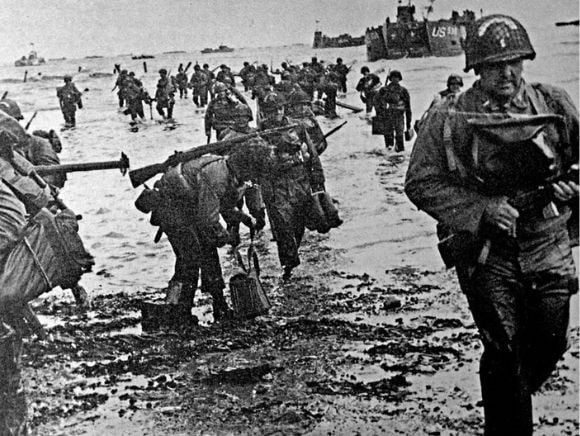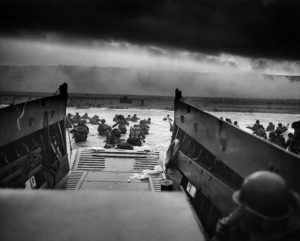
(Photo by: Universal History Archive/Universal Images Group via Getty Images)
Living World War II heroes; their numbers are dwindling to a precious few, including those who waded ashore at Normandy, France, in 1944. Nevertheless, their stories of sacrifice and indescribable heroism resound in the works of Stephen E. Ambrose (Band of Brothers), Cornelius Ryan (The Longest Day: 6 June 1944), and Rick Atkinson (The Guns at Last Light), to name just three. But behind the heroics and accomplishments in the most horrific of war’s arenas, the numbers tell an equally compelling story of a defining moment in history. Positioning combat naval vessels and landing craft, and moving fighting men, armored vehicles, tanks, and artillery over a heavily defended beachhead 50 miles wide, American, British, and other allied forces pulled off an amphibious assault never equaled before or since. By the time “Operation Overlord,” the code name for the Normandy invasion, was ready to kick off, 2,876,439 American officers and enlisted men had deployed to Britain.
However, the first casualties leading up to the invasion of France on June 6, 1944, were sustained 40 days earlier, on April 28, during a rehearsal for the Normandy landing code-named “Exercise Tiger.” As the exercise progressed, most of the participating infantry had disembarked on the shore at Slapton Sands, England. “[E]ight tank landing ships (LSTs) were making their way towards Slapton. These ships carried engineers, quartermaster staff, signalers, medics and some infantry as well as tanks, trucks, jeeps, and equipment,” according to the online historical account “The Story of Exercise Tiger.” As the LSTs approached the beach, the US vessels were attacked with torpedoes and gunfire by nine German E-boats (German fast-attack vessels). The surprise engagement left 749 American soldiers and sailors dead before a single boot hit the beaches of Normandy.
But when those combat foot soldiers did hit the beaches of Normandy, the invasion came with a vengeance. In preparation for the initial allied attack, the British 6th Airborne Division, at 12:16 AM, landed 181 men in gliders at the Caen canal behind German lines. That was just the beginning of 7,900 British paratroopers hitting the silk over France. Additionally, not long after and well before the invasion, members of the 82nd and 101st Airborne paratroopers hit the ground to take out German artillery and other targets to the east of the invasion beaches. Approximately 15,500 US airborne forces joined the battle that day.
As the early morning mist lifted at H-hour, 6:30 AM, Germans manning the machinegun bunkers and fortifications on Utah, Omaha, Gold, Juno, and Sword beaches, saw the first of a 6,939-ship invasion fleet. During the opening moments of the invasion, 200 naval combat vessels – battleships, monitors, cruisers, and destroyers – began a naval bombardment of the landing beaches and fortifications. During that and subsequent days, the five landing beaches would see 73,000 American, 21,400 Canadian, and 61,715 British combat troops move from the beachhead to securing the battlefield, 156,115 men in all.

(Photo by: Universal History Archive/Universal Images Group via Getty Images)
Leaving the ramps of the landing craft was just the beginning. In most cases, the distance to where soldiers could dig in for some cover was 200 yards of barbed wire and machinegun fire – a dash dodging death. On Omaha Beach, the distance from the water to fight across was 300 yards of blistering enemy fire. By the end of D-Day, American losses numbered 6,000. More than half that number fell on Omaha Beach. Total allied losses were 10,500. However, “Less than a week later, on June 11, the beaches were fully secured and over 326,000 troops, more than 50,000 vehicles, and some 100,000 tons of equipment had landed at Normandy,” History.com explained.
Additionally, above the fighting on the ground on D-Day, 11,590 aircraft participated – fighters, bombers, airborne troop carriers, and cargo carriers. In the skies over the coast of France, allied aircraft dropped 10,395 tons of bombs on June 6. Allied Air Forces flew over 11,000 missions. Over 800 troop carrier craft participated in the airborne operations, with 21 shot down or missing in the initial airdrop missions. Follow-on resupply missions included 270 troop carrier aircraft. However, of the planes that took off to drop supplies and provisions, 13 were lost. American and British troop carriers, including transports and gliders, delivered roughly 24,000 troops to France on June 6.
The young soldiers, airmen, and sailors who participated in Operation Overlord were part of an endeavor unlikely ever to be repeated. Even by today’s standards, the sheer numbers of combat troops, tons of equipment, vehicles, aircraft, and ships involved are staggering. Yet, walking the quiet beaches of Normandy today, it’s hard to remember that one day in 1944 – which was anything but tranquil.
The views expressed are those of the author and not of any other affiliation.
Remember to check out the web’s best conservative news aggregator
Whatfinger.com — the #1 Alternative to the Drudge

